How to Transition Your Lawn from Cool to Warm Season Grass
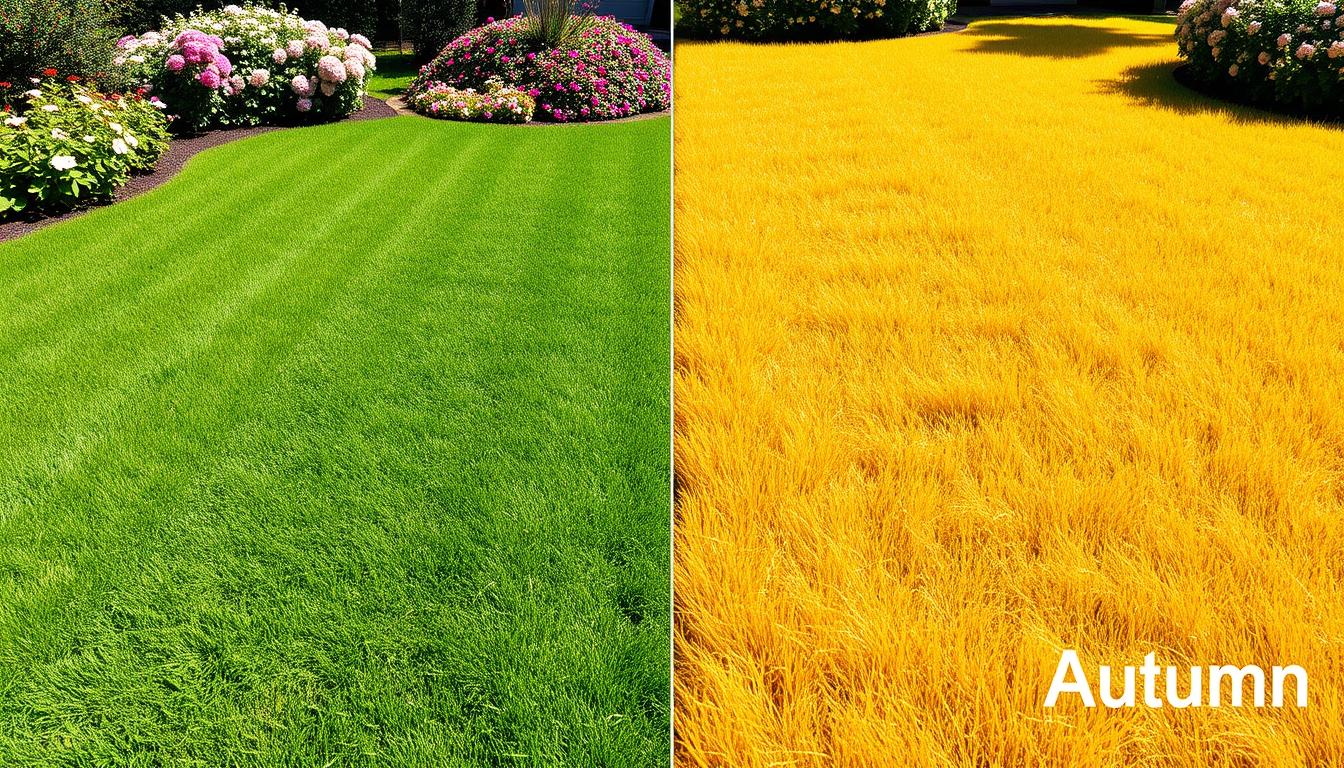
Did you know overseeding is used on golf courses and sports fields?
It helps protect them from foot damage and weeds in winter. As a homeowner, switching your lawn to warm season grass can be a big change. But, it needs careful planning and action.
In this guide, I’ll share tips and strategies for this transition. You’ll learn how to make your yard lush and vibrant all year, no matter the weather.
Key Takeaways
- Understand the differences between cool season and warm season grasses to make an informed decision for your lawn.
- Properly prepare your lawn for the transition by testing and amending the soil as needed.
- Explore various methods for establishing a new warm season lawn, including seeding, sodding, and hydroseeding.
- Maintain your warm season lawn with the right mowing, watering, and fertilization techniques.
- Time the transition process carefully, taking into account seasonal changes and weather patterns.
Whether you’re in the Transition Zone or want a drought-tolerant grass, this guide has you covered. It will give you the knowledge and tools for a successful lawn-care journey. So, let’s start and transform your outdoor space!
Understanding Warm and Cool Season Grasses
Knowing the difference between warm and cool season grasses is key for lawn care. Each type grows differently, likes different temperatures, and looks unique. Homeowners need to think about these when changing their lawn.
Warm Season Grass Types
Grasses like Bermudagrass, Zoysiagrass, and St. Augustinegrass love warm weather. They turn brown when it gets cold. These grasses need less water than cool season types.
Cool Season Grass Types
Cool season grasses, like Tall Fescue and Kentucky Bluegrass, do well in cooler weather. They stay green longer into fall. But, they need regular watering in summer to stay green.
Transition Zone Lawns
People in transition zones face special challenges. These areas can grow both warm and cool season grasses. Knowing the needs of each grass is key to a healthy lawn all year.
| Characteristic | Warm Season Grasses | Cool Season Grasses |
|---|---|---|
| Growth Pattern | Go dormant in early to mid-fall, green up in late spring | Stay green longer into the fall, green up in mid-spring |
| Water Needs | Lower water requirements | Higher water needs, can struggle without consistent summer watering |
| Shade Tolerance | Intolerant of shade | Can tolerate some shade |
| Photosynthesis | C4 photosynthesis | C3 photosynthesis |
“Understanding the unique growth patterns and characteristics of warm season and cool season grasses is crucial for successfully transitioning your lawn and maintaining a healthy, vibrant landscape year-round.”
Preparing Your Lawn for Transition
Starting the journey to change your lawn from cool season to warm season grass is exciting. But, it’s key to prepare well for success. Begin by checking your soil’s health with a detailed soil test.
Soil Testing and Amendments
A soil test gives you important info about your lawn’s soil. It shows the pH level, nutrient balance, and organic matter. This info helps figure out what soil amendments you need for your new warm season grass.
- Get a soil test from your local extension office or a trusted lab.
- Look at the results to find any soil imbalances or missing nutrients.
- Use the test findings to add the right soil amendments, like lime or compost, to fix pH and nutrients.
By preparing your soil well, you’re setting up your lawn for success. Remember, lawn transition preparation, soil testing, and soil amendments are key for a smooth transition.
“A well-nourished soil is the foundation for a vibrant, resilient lawn.”
With the right soil, you’re on your way to a stunning warm season lawn. It will make your neighbors jealous.
Establishing a New Warm Season Lawn
Changing your lawn to warm-season grass is exciting. It brings a lush, strong turf that loves the warm weather of the south. You can choose to plant grass seed, lay sod, or use hydroseeding to start your new lawn.
Planting Grass Seed
Seeding is a budget-friendly way to start a new lawn. Seeds like Bermudagrass, Zoysia, and Bahiagrass grow fast, showing results in 7 days. They reach full growth in 22 days. Plant seeds when the soil is 65°F for the best start.
Laying Sod
Laying sod gives you an instant green lawn. Grasses like Bermudagrass and Zoysia are common in sod. But, sod costs more than seeding and needs well-prepared soil for a good job.
Hydroseeding
Hydroseeding sprays a mix of seed, mulch, and water on the soil. It’s great for big areas or hard spots. It spreads seed evenly and helps it stick to the soil for quick growth.
Choosing the right method for your lawn is key. Soil prep, care, and timing are crucial for a healthy warm season lawn. With the right knowledge, you can have a beautiful, easy-to-care-for lawn that everyone will admire.
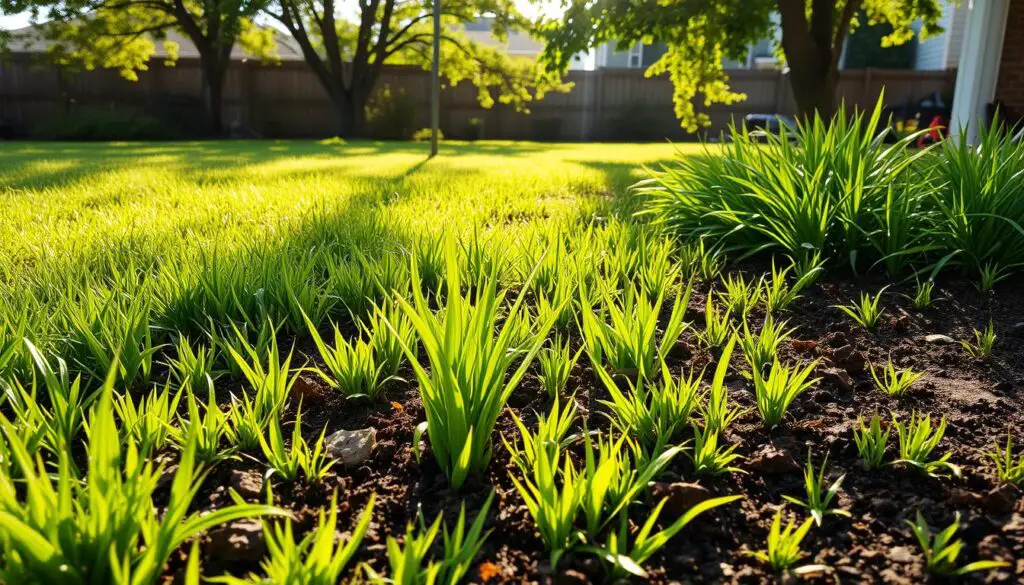
| Establishment Method | Advantages | Disadvantages |
|---|---|---|
| Grass Seed |
|
|
| Sod |
|
|
| Hydroseeding |
|
|
Proper Mowing Techniques for Warm Season Grass
Keeping your warm season lawn healthy means mowing it right. The height you mow depends on the grass type. Warm season grasses do best when mowed higher than cool season grasses. They usually need to be cut between 3 to 4 inches, based on the type.
It’s also important to follow the “one-third” rule. This means you should never cut more than one-third of the grass blade in one go. This rule helps avoid damaging the grass and keeps it healthy.
| Warm Season Grass Type | Recommended Mowing Height (inches) |
|---|---|
| Bermuda Grass | 1.5 – 3 |
| Zoysia Grass | 2 – 3 |
| Centipede Grass | 1 – 2 |
| St. Augustine Grass | 3 – 4 |
Using sharp mower blades is key for warm season grass mowing. Dull blades can damage the grass, making it more prone to disease. Sharpen your mower blades 1-2 times a year, depending on your lawn size.
The last mow of the season for warm season grasses is in the fall, usually by the end of October. This gets the lawn ready for winter and prevents disease or vole problems.
“Mowing practices that ensure taller grass help shade out weed seeds, keep the soil cooler, and promote longer roots, enhancing the grass’s ability to withstand drought and access nutrients.”
By sticking to these mowing height and mowing frequency tips, you can keep your warm season lawn looking great all season.
Watering Requirements for Warm Season Lawns
Keeping your lawn green and lush needs careful watering, more so when switching to warm season grasses. Grasses like bermudagrass and zoysiagrass use water more efficiently than cool season grasses.
Most grasses need about 1 inch of water each week to grow well in warm weather. But, the exact amount depends on the grass type and soil. Some grasses, like Kentucky bluegrass, don’t do well when dry, while others, like fine fescues, can handle drought better.
For warm season lawn watering, use deep, less frequent watering to soak the roots up to 4 inches deep. This method helps fight weeds and encourages strong root growth. In Virginia, you might need to water every three to four days to avoid wasting water.
Watering your lawn best in the early morning, between 4 am and 12 noon, helps it absorb water better. This time also reduces evaporation, which is high during the day. Using portable sprinklers that keep water close to the ground can also help save water.
| Grass Type | Water Requirement (inches per week) |
|---|---|
| Bermudagrass | 1 – 1.5 |
| Zoysiagrass | 1 – 1.5 |
| Centipedegrass | 0.5 – 1 |
| St. Augustinegrass | 1 – 1.5 |
| Kentucky Bluegrass | 2 – 2.5 |
Using soil moisture sensors can help you water your lawn just right. These tools can cut down watering needs by 50 to 75%. This way, you can keep your lawn healthy and save water at the same time.
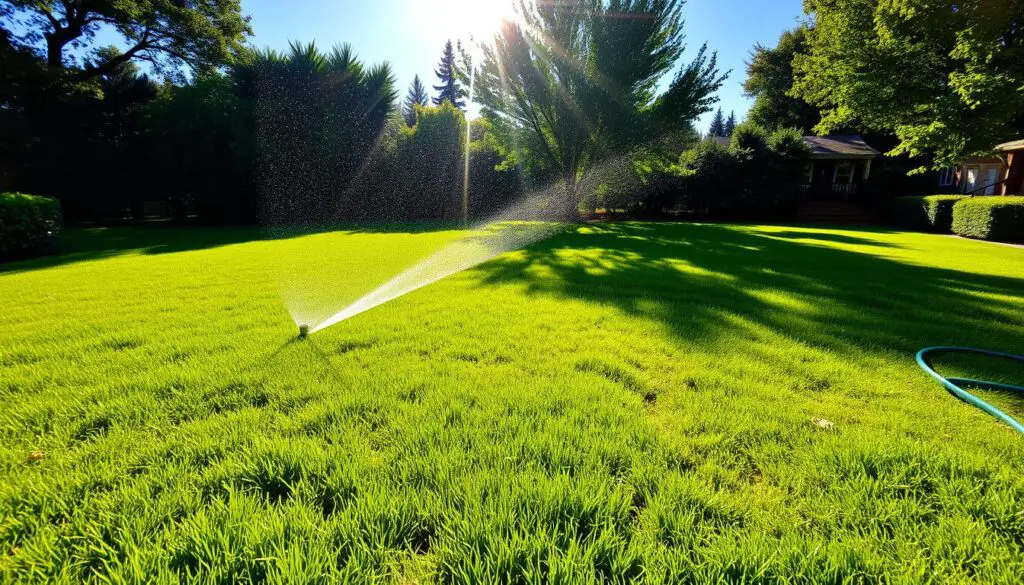
Keep in mind, your lawn’s water scheduling needs can change based on soil, weather, and grass type. By following these tips and adjusting as needed, you can have a lush, water-saving lawn all season long.
Timing the Transition from Cool to Warm Season Grass
Switching your lawn from cool to warm season grass needs careful timing. This ensures the new grass grows well and keeps your lawn healthy all year.
The right time to start the change is in late spring or early summer. This is when the soil is warm and the grass can grow best.
- Begin the transition four to six weeks before the first frost. This gives the new grass time to grow strong roots for winter.
- Watch the soil temperature closely. Warm season grass needs soil over 65°F to 70°F to grow. The air should be between 75°F and 90°F for best growth.
- Consider your local climate. The south has longer warm seasons for grass, while the north is better for cool season grasses.
Knowing when to switch your lawn is key for a smooth transition. By following these tips, you can have a vibrant lawn that does well all year.
“The key to a successful lawn transition is finding the right balance between cool and warm season grasses, and timing the process just right to ensure the new grass takes hold and flourishes.”
Overseeding with cool to warm season grass
As a homeowner, you might think about changing your cool season lawn to warm season grass. Overseeding is a way to do this by planting warm season grass seed into your existing lawn. This method is cost-effective and easy, but it has its own set of benefits and challenges.
Overseeding lets you slowly add warm season grass to your lawn. This is good for big lawns or if you want some green during the change. It’s also great for fixing bare spots or thin areas.
Timing is everything when overseeding. For tall fescue and perennial ryegrass, use about 4 pounds of seed per 1,000 square feet. Start with a fertilizer of 0-25-25 at 1 pound per 1,000 square feet to help roots grow. Water lightly 2 to 5 times a day to help the seed germinate in 5 to 7 days.
Once the new grass grows, you need to mow it right. Cut it back to 3 inches about 2 weeks after seeding. Use urea fertilizer of 1/4 pound of nitrogen per 1,000 square feet, a week apart, to help it grow.
Overseeding is a good choice for transitioning lawns, but it takes time. It might take several seasons for the warm season grass to take over. Be patient and keep up with maintenance for a successful overseeding cool to warm season change.
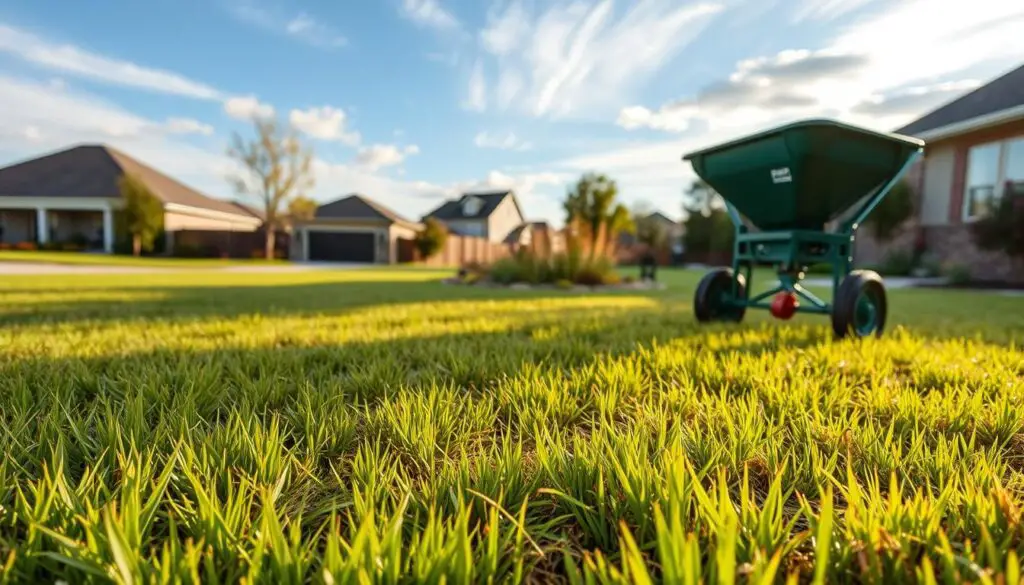
“Overseeding can be a great way to gradually introduce warm season grass into your lawn, but it requires careful planning and attention to detail to ensure success.” – Sam Masser, author
Spring Lawn Care for Transitioning Lawns
When your lawn changes from cool to warm season grass, it needs special care in spring. Applying pre-emergent herbicides is key to stop weeds like crabgrass. These weeds can harm the new warm season grass.
Pre-Emergent Herbicide Applications
Apply pre-emergent herbicides like Prodiamine when soil is about 50-55°F. This is usually early spring. It stops crabgrass and other weeds from growing. – Richard, ecology and lawn health specialist
Apply a second round of Prodiamine when soil hits 65-70°F. This extra step helps keep weeds away.
In areas where both warm and cool season grasses grow, soil gets warmer than usual. This means you might need to apply pre-emergents sooner. Keep an eye on your soil temperature.
For lawns like Bermuda and Zoysia, using pre-emergents is vital. They keep your lawn looking good. You can also use Image for Southern Lawns and Celsius weed control for more weed protection.
Getting the timing and product right is crucial for spring lawn care. By doing this, your lawn will transition well and look great all season.
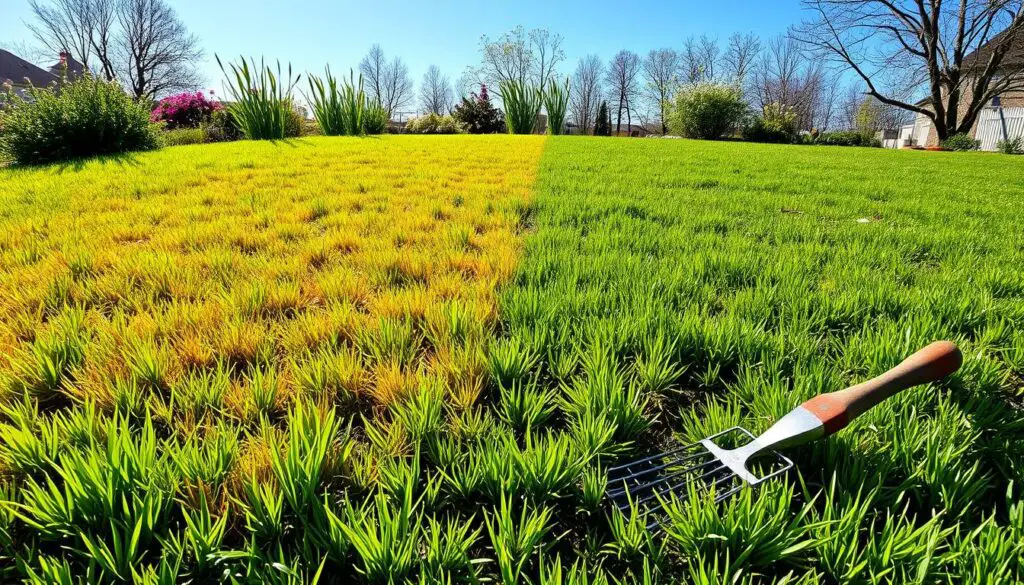
Fall Lawn Maintenance for Warm Season Grasses
As summer fades, keeping your warm season grass lawn healthy is key. In the fall, tasks like mowing, fertilizing, and overseeding are important. They help your lawn get ready for the cold months and the next growing season.
Mowing is a top fall lawn care task for warm season grasses. Cut the grass less often but keep it at the right height. This helps it get ready for dormancy while looking neat.
Fertilizing is also vital in the fall. Stop feeding your warm season lawn in early August to late September. This lets the grass slowly get ready for the cold without growing too much.
- Avoid dethatching and aerating warm season lawns in the fall; save these tasks for spring and early summer.
- Continue watering warm season lawns as long as they are growing, and let nature take over once they slow down.
- Mulch small quantities of fallen leaves on the lawn, but remove heavy accumulations to prevent suffocation of the grass.
By following these fall lawn care and warm season grass maintenance tips, your lawn will smoothly transition into the cooler months. This will prepare it for a lush, vibrant landscape in the next growing season.
Common Challenges During the Transition
Switching my lawn from cool to warm season grass has been tough. Weed invasion is a big problem. Weeds like crabgrass and goosegrass fill in gaps left by the new grass. To fight this, I’ve been using a pre-emergent herbicide when the soil is just right.
Managing uneven growth has also been a challenge. Some parts of my lawn are doing great, while others lag behind. I’ve had to adjust how often I mow and water. Luckily, warm season grasses like bermudagrass are tough and have helped my lawn get better.
Unseasonable weather has also tested my patience. A hot spell killed off my ryegrass, and I had to act fast. Using the right fertilizer, like ammonium sulfate and Soil Burst, has helped my warm season grass grow strong. This keeps my lawn looking good, even in tough weather.
FAQ
What are the key differences between warm season and cool season grasses?
How do I prepare my lawn for the transition from cool season to warm season grass?
What are the different methods for establishing a new warm season lawn?
How do I properly mow a warm season lawn?
How much water does a warm season lawn need?
When is the best time to transition my lawn from cool season to warm season grass?
Can I overseed my existing cool season lawn with a warm season grass variety?
What should I do to care for my lawn during the spring after the transition?
How do I maintain my warm season lawn in the fall?
What are some common challenges I might face when transitioning my lawn?
Source Links
- https://www.totallandscapecare.com/business/article/15041383/transition-overseeded-lawns-back-to-warm-season-grass
- https://thelawncarenut.com/blogs/news/spring-prep-warm-season-cool-season-and-transition-zone-lawns?srsltid=AfmBOor6ndGewkNhpy8kO3mmVyUZXN2SeSUHPPRe1mLTjzfxxPnIgM3N
- https://www.highcountrygardens.com/content/gardening/warm-season-grass-vs-cool-season-grass
- https://extension.illinois.edu/blogs/grasses-glance/2022-05-23-understanding-cool-season-and-warm-season-grasses
- https://efotg.sc.egov.usda.gov/references/public/va/NWSG_CSG_comparison.pdf
- https://www.lawnstarter.com/blog/lawn-care-2/guide-to-growing-grass-in-the-transition-zone/
- https://thelawncarenut.com/blogs/news/spring-prep-warm-season-cool-season-and-transition-zone-lawns?srsltid=AfmBOoqL3Kuy5ta_bv_2eB7KZ-WCDbOZ8p59g8aL4p5HPH034sYkwnQ6
- https://www.lawnstarter.com/blog/lawn-care-2/warm-season-grass-growing-guide/
- https://www.pennington.com/all-products/grass-seed/resources/month-by-month-care-calendar-for-warm-season-lawns
- https://extension.umd.edu/resource/starting-new-lawn
- https://weedman.com/en-ca/resources/lawn-care-library/mowing-tips
- https://extension.umn.edu/lawn-care/mowing-practices-healthy-lawns
- https://plantsod.com/articles-and-tips/warm-season-grass-maintenance-guide?srsltid=AfmBOoowjiMWX-VHHKIWmY3Z7Y5kwdu91hnMG2qqwlNsIiEpx_RKbt07
- https://www.pubs.ext.vt.edu/430/430-010/430-010.html
- https://extension.colostate.edu/topic-areas/yard-garden/watering-established-lawns-7-199/
- https://plantsod.com/articles-and-tips/warm-season-grass-maintenance-guide?srsltid=AfmBOoqPnvrpeSeoo4J8_1jLkB1cpLJprIup3NBjFlYVoBPAfqiuD_dq
- https://bioadvanced.com/warm-season-vs-cool-season-grasses
- https://tdigreenservices.com/blog/how-to-transition-warm-season-turf-for-cooler-weather/
- https://plantforsuccess.com/cool-season-grass-vs-warm-season-grass/
- https://www.thelawnforum.com/threads/cool-season-overseed-guide.6250/
- https://getlawnbright.com/blogs/lawnintelligence/fall-overseeding-guide-for-cool-season-grasses?srsltid=AfmBOorVp7OcBkh7ssufcSUAl9zndIvmr8zKw19TqqX5R-NEfcmmwl2B
- https://thelawncarenut.com/blogs/news/spring-prep-warm-season-cool-season-and-transition-zone-lawns?srsltid=AfmBOorVxyTEyG1tCQwP8NX89bkZRNEQZJ8vR0jyf7i9mzN_fja9bE-w
- https://turfmasterslawncare.com/blog/spring-lawn-care-guide
- https://lawnlove.com/blog/lawn-care-calendar-warm-season-grass/
- https://www.pennington.com/all-products/grass-seed/resources/countdown-to-winter-checklists-for-fall-lawns
- https://todayshomeowner.com/lawn-garden/guides/fall-lawn-care-guide/
- https://blog.westcoastturf.com/suffering-through-a-tough-lawn-transition/
- https://www.thelawnforum.com/threads/cool-season-lawn-guide.1595/
- https://thelawncarenut.com/blogs/news/spring-prep-warm-season-cool-season-and-transition-zone-lawns?srsltid=AfmBOooiAuzPdvydxypX9QvopocHetyQV0xjlAecOUwmI98EyWu6l5Si

